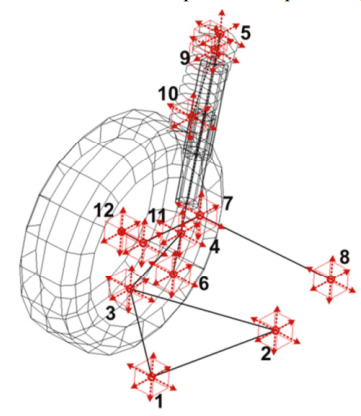to add a picture, to what Greg & Brian have allready said, take a look below:
Here you have shown some elements (red & green), which can be seen as the "links" of a suspension. At the ends, of these links you have points (the small spheres) where they would connect to either the chassis/structure or on the other side to the part which holds the wheel in place, called knuckle, upright, strut(housing), wheel carrier, axle(sometimes spindle too) etc.
In this example the points are numbered, and possible force vectors are shown.
here the location of some of the "hard points" (coordinates) is shown as coordinates in 3D space (x-y-z w.r.t. a reference point).
You see the "links" which connect the points with each other.
so in a roundabout way, you could say "hardpoints" are the joints/points where a "suspension link" connects to another part/component.
Another expression, you may find is "coordinates" or "pick-up points".
As Brian said, often the location of some of these points is strictly defined in space (as x-y-z coordinates), mainly in racing, and mainly refering to the chassis side, while the shape & lengths of the "links" is free.
At the end of the day, a first order approach to suspension analysis deals with the geometric relationships / kinematics of the movements. How on part change it's position w.r.t another, a combination of translations (linear movements) and rotations (angular movements). Then on a higher level, you may start to consider the structural aspects, how do these components react when loads are applied (static & dynamic). You may will find, that some parts start to deflect under load, and that the position of some of your "hard points" change when load(s) are applied ( structural deflections / compliance) - this is where the "fun" really starts.
But as a starting point, dig out any good book on kinematics/geometry (preferable 3D), it doesn't even need to be related to "vehicle suspensions", a classical 4-bar linkage is maybe a good starting point, to learn some of the basics.
see here, just for a quick example:
if you look around google, youtube etc. you will find plenty of stuff, to keep you busy for a while
good luck

![[2thumbsup] [2thumbsup] [2thumbsup]](/data/assets/smilies/2thumbsup.gif)


